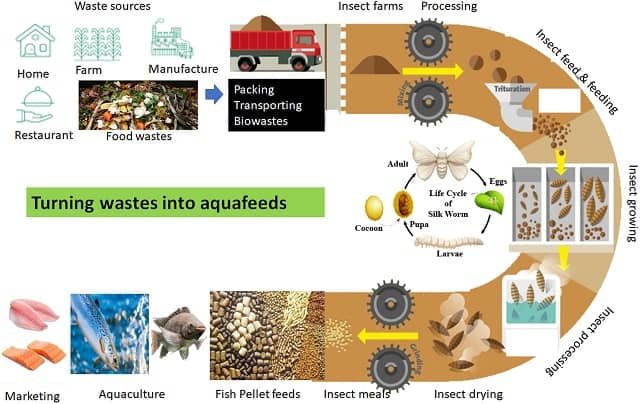An international team from Seed Wilmar Indonesia Ltd, South China Agricultural University, Brawijaya University, Nanyang Technological University, and National University of Singapore published a scientific review summarizing the application of eight species of insect meal in aquaculture feed formulations.
The study also discusses the challenges of replacing fish meal with insect meal in fish feeds and outlines a research roadmap to establish insect meal as a significant protein source for the aquaculture industry.
Insects used in aquaculture feeds
Insects are one of the natural food sources for fish, especially for carnivorous and omnivorous species.
While the use of insects in aquaculture feeds began 40 years ago, there has been an increase in insect meal production in China, Europe, North America, Australia, and Southeast Asian countries.
Among the tested and used species for industrial aquaculture feed production, eight species have shown the greatest potential: silkworms (Bombyx mori), black soldier flies (Hermetia illucens), houseflies (Musca domestica), yellow mealworms (Tenebrio molitor), lesser mealworms (Alphitobius diaperinus), house crickets (Acheta domesticus), banded crickets (Gryllodes sigillatus), and Jamaica field crickets (Gryllus assimilis).
These eight insect species have been extensively studied as protein sources to replace fish meal in aquaculture feeds, and they are approved for use as feed ingredients in the European Union’s legislation.
According to the study, these eight insect species have a high level of crude protein ranging from 42.1% to 63.3%. While this range is lower than fish meal, it is very similar to soybean meal. Additionally, the amino acid profiles of insects are diverse.
“The eight insect species have lower fat content compared to fish meal, with fat content ranging from 8% to 36%,” the researchers report.
Stay Always Informed
Join our communities to instantly receive the most important news, reports, and analysis from the aquaculture industry.

Current status of insect use in farmed fish feeding
Recent studies have focused on feeding trials to determine the effects of adding insect meal to aquaculture feeds for various species.
The study provides a comprehensive summary of the current knowledge about using these eight insects in aquaculture feeds for species such as common carp (Cyprinus carpio), chum salmon (Oncorhynchus keta), olive flounder (Paralichthys olivaceus), Rohu (Labeo rohita), Mahseer putitora (Tor putitora), rainbow trout (Oncorhynchus mykiss), Japanese sea bass (Lateolabrax japonicus), Atlantic salmon (Salmo salar), European sea bass (Dicentrarchus labrax), turbot (Scophthalmus maximus), tilapia, among others.
Insect farming and processing
A crucial aspect of insect farming is ensuring efficient egg production in both quantity and quality to recover large volumes of organic matter, maintain consistent larval production, and sustain the breeding population.
The study notes that insect farms are prevalent in China and Thailand, with Thailand being a significant producer of edible insects, boasting about 20,000 insect farms. Cricket farming has also been studied in Thailand, Cambodia, Laos, the Democratic Republic of the Congo, and Kenya.
However, the insect meal production industry is still young and will require significant investments, research, and development to mature into a competitive and viable product.
“To minimize the existing high production costs, more research on automation processes is required. As long as production levels remain low, the price will continue to be a barrier to greater adoption of insect proteins,” the researchers emphasize.
To produce insect meal, several essential steps are involved:
- Ensuring a continuous supply of biomass because the nutrient composition of the growing substrates greatly influences critical production factors like total yield, body weight, and larval nutrient composition.
- Decontamination through thermal or radiation processes.
- Drying the insect pupae or the entire body through convection and contact/radiation.
- Grinding the insects or pupae and defatting the insects using mechanical pressing and aqueous and solvent-based methods.
- Protein extraction, and for species containing chitin, removing this compound is essential.

Conclusion
“The eight insect species discussed here have been used to replace fish meal in aquaculture feeds. These insects have high protein, fat, and calorie content, making them excellent components of aquaculture feeds. Many feeding trials with various aquaculture species have demonstrated that these insects could successfully replace part of the fish meal in aquaculture feeds,” conclude the researchers.
They also highlight that most studies recommend replacement rates of less than 30%, but it has been reported that higher substitution rates of fish meal are technically possible in some aquaculture species.
Limitations to using insect meal in farmed fish feeding include variations in the nutritional values of insects, which differ among species and development stages within a species.
Finally, the study authors predict that insect meal production will remain small compared to other feed ingredients in the coming years.
Reference (open access)
Yuzer Alfiko, Dizhi Xie, Retno Tri Astuti, Joey Wong, Le Wang. 2022. Insects as a feed ingredient for fish culture: Status and trends, Aquaculture and Fisheries, Volume 7, Issue 2, 2022, Pages 166-178, ISSN 2468-550X, https://doi.org/10.1016/j.aaf.2021.10.004.
Editor at the digital magazine AquaHoy. He holds a degree in Aquaculture Biology from the National University of Santa (UNS) and a Master’s degree in Science and Innovation Management from the Polytechnic University of Valencia, with postgraduate diplomas in Business Innovation and Innovation Management. He possesses extensive experience in the aquaculture and fisheries sector, having led the Fisheries Innovation Unit of the National Program for Innovation in Fisheries and Aquaculture (PNIPA). He has served as a senior consultant in technology watch, an innovation project formulator and advisor, and a lecturer at UNS. He is a member of the Peruvian College of Biologists and was recognized by the World Aquaculture Society (WAS) in 2016 for his contribution to aquaculture.




